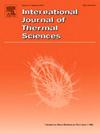Enhanced heat transfer study of solid lithium target for BNCT based on Gyroid structure function regulation
IF 4.9
2区 工程技术
Q1 ENGINEERING, MECHANICAL
International Journal of Thermal Sciences
Pub Date : 2025-05-17
DOI:10.1016/j.ijthermalsci.2025.110000
引用次数: 0
Abstract
Accelerator-driven neutron target stations generate a considerable amount of deposited heat that requiring timely and efficient removal to maintain safe operation. In this study, a Gyroid structure substrate was proposed to improve the heat removal capability of the BNCT neutron target stations, and the “through-hole” factor (α) was introduced to optimize the standard Gyroid structure, aiming to enhance its convective heat transfer performance. The flow and heat transfer characteristics of the improved Gyroid structure was analyzed using numerical simulations and experimental measurements. The results show that as the value of α increases, Gyroid structure peak temperature (Tmax) decreases by 4.9–7.4 K, the convective heat transfer coefficient (h) increases by 4.3 %–8.2 %, and the Nusselt number (Nu) increases by 0.7 %–3.5 %. Taking the comprehensive performance evaluation criterion (PEC) as the evaluation index, it is recommended to select α = 2.0 to achieve optimal results. This study provides the theoretical support and technical guidance for the design and development of new neutron target stations.
基于陀螺结构功能调节的BNCT固体锂靶强化传热研究
加速器驱动的中子靶站会产生相当多的沉积热量,需要及时有效地去除以保持安全运行。本研究提出了一种Gyroid结构衬底来提高BNCT中子靶站的散热能力,并引入“通孔”因子(α)对标准Gyroid结构进行优化,以提高其对流换热性能。采用数值模拟和实验测量相结合的方法分析了改进后的陀螺结构的流动和换热特性。结果表明:随着α值的增大,陀螺结构峰值温度(Tmax)降低4.9 ~ 7.4 K,对流换热系数(h)增加4.3% ~ 8.2%,努塞尔数(Nu)增加0.7% ~ 3.5%。以综合绩效评价标准(PEC)作为评价指标,建议选择α = 2.0以达到最优效果。该研究为新型中子靶站的设计与开发提供了理论支持和技术指导。
本文章由计算机程序翻译,如有差异,请以英文原文为准。
求助全文
约1分钟内获得全文
求助全文
来源期刊

International Journal of Thermal Sciences
工程技术-工程:机械
CiteScore
8.10
自引率
11.10%
发文量
531
审稿时长
55 days
期刊介绍:
The International Journal of Thermal Sciences is a journal devoted to the publication of fundamental studies on the physics of transfer processes in general, with an emphasis on thermal aspects and also applied research on various processes, energy systems and the environment. Articles are published in English and French, and are subject to peer review.
The fundamental subjects considered within the scope of the journal are:
* Heat and relevant mass transfer at all scales (nano, micro and macro) and in all types of material (heterogeneous, composites, biological,...) and fluid flow
* Forced, natural or mixed convection in reactive or non-reactive media
* Single or multi–phase fluid flow with or without phase change
* Near–and far–field radiative heat transfer
* Combined modes of heat transfer in complex systems (for example, plasmas, biological, geological,...)
* Multiscale modelling
The applied research topics include:
* Heat exchangers, heat pipes, cooling processes
* Transport phenomena taking place in industrial processes (chemical, food and agricultural, metallurgical, space and aeronautical, automobile industries)
* Nano–and micro–technology for energy, space, biosystems and devices
* Heat transport analysis in advanced systems
* Impact of energy–related processes on environment, and emerging energy systems
The study of thermophysical properties of materials and fluids, thermal measurement techniques, inverse methods, and the developments of experimental methods are within the scope of the International Journal of Thermal Sciences which also covers the modelling, and numerical methods applied to thermal transfer.
 求助内容:
求助内容: 应助结果提醒方式:
应助结果提醒方式:


